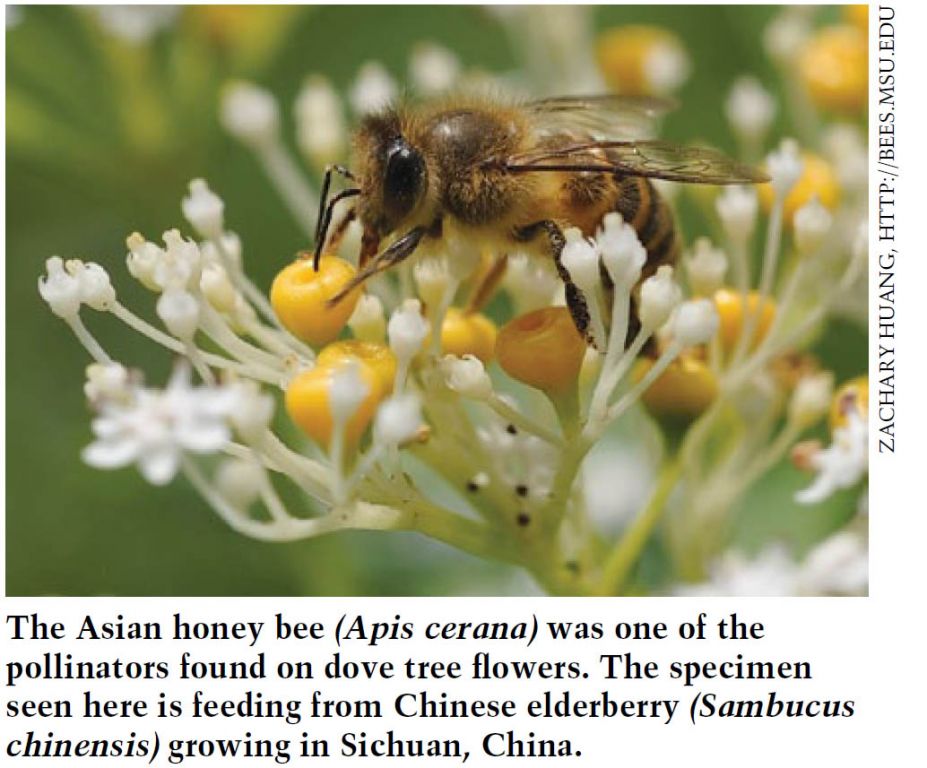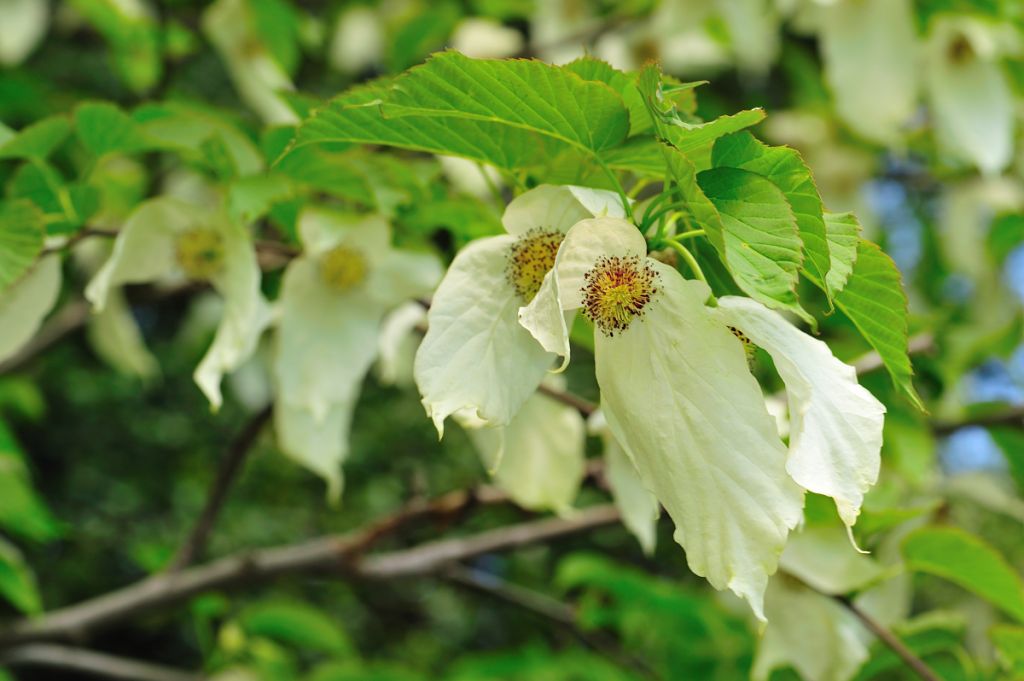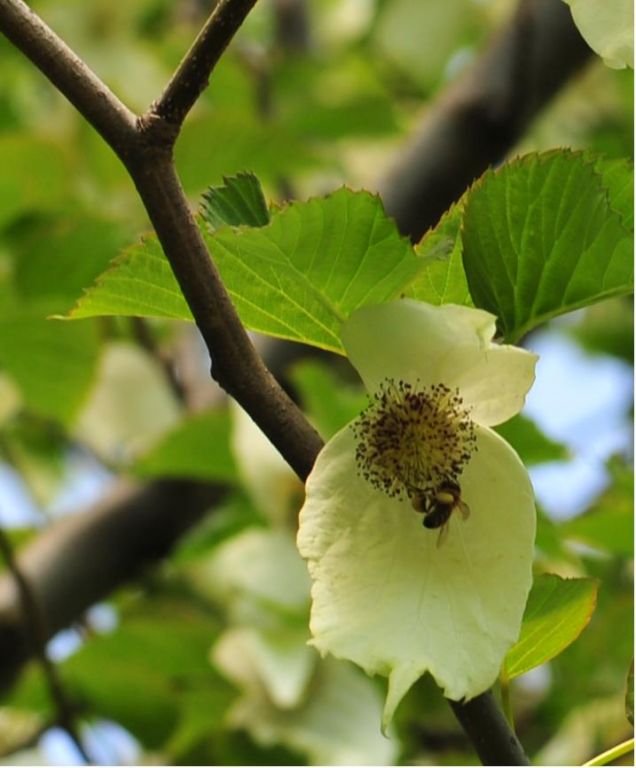博文
上过哈佛的小蜜
 精选
精选
||||
1. 这个是四川大学到看熊猫的路上拍的。 是正骨草的花。 我所知的唯一的整个小花变成蜜腺的花。
你看那小蜜的舌头正舔的, 黄色的小碗儿, 就是一个蜜腺。 其它白色的是正常的小花。 这些黄色的蜜腺, 大概10-15%混在花中, 吸引蜜蜂去采蜜, 采蜜的过程中, 把花粉给传了。
而珙桐呢, 是很不同的另外一个植物。
第一个特殊, 是因为属名(Davidia)和科名(Davidiaceae),都是按俺家儿子取名的
 。(别急, 俺家女儿也有植物名字的, 以后再表)。
。(别急, 俺家女儿也有植物名字的, 以后再表)。而且她们开花的时候, 白色的苞片象雨伞把花保护起来, 远看象满树的白鸽要飞起来, 怪不得英文就叫鸽子树,Dove Tree。鸽子代表和平, 我站在树下是有和平的感觉, 那些花没有鲜艳的颜色, 但随着鸽子在风中的飞舞,我能闻到阵阵的幽香。
我现在找不到她们的E了。 不记得是一定要中蜂的片片(好象是), 还是没有提是关于珙桐这个植物的(好象也是)。 反正我有一个小蜜在这个珙桐花上, 是2011年5月在纽约的植物园拍的。 但是没有给他们。 还有可能就是2010年就问我要片片了, 或是2011年5月前要的。 反正是我有片没有机会给他们, 最后使他们片不对题。
因为文章是关于珙桐的白色苞片对花起雨伞的作用,以及对蜜蜂的吸引, 但是我的片片是中蜂采正骨草。
为了服务文章, 如果有紫外的片片就更好了。 我那次没有带紫外镜头。 也不知道白色苞片会吸收紫外线。 这是黄老师的文章(不是我, 见下面链接)提出的, 我当然是受到杂志才学习到这些的。
2.我拍的珙桐花。
3. 好远的地方有一个小蜜。 在采粉!
武汉大学黄双全教授和同事的文章在这里: http://arnoldia.arboretum.harvard.edu/pdf/articles/2011-68-3-white-bracts-of-the-dove-tree-davidia-involucrata-umbrella-and-pollinator-lure.pdf
根据张珑提供的资料, 修正的百度:
珙桐为落叶乔木。可生长到20-25米高,叶子广卵形,边缘有锯齿。本科植物只有一种,两个品种。 只是一种叶面有毛,另一种是光面。花奇色美,是1000万年前新生代第三纪留下的孑遗植物,在第四纪冰川时期,大部分地区的珙桐相继灭绝,只有在我国南方的一些地区幸存下来,成为了植物界今天的“活化石”。
英文介绍
The species was introduced from China to Europe and North America in 1904, and is a popular ornamental tree in larger gardens. Most trees in cultivation are var. vilmoriniana, which has proved much better able to adapt to the climatic conditions in Europe and North America.
The genus Davidia is named after Father Armand David (1826–1900), ("Père David"), a French Vincentian[disambiguation needed ![]() ] missionary and keen naturalist who lived in China, and who is also commemorated in the Chinese White Pine Pinus armandii and Père David's Deer. He was also the first westerner to describe another rare Chinese endemic, the Giant panda (Ailuropoda melanoleuca).
Although it was David who first described the tree in 1905, a single
tree found at over 2,000 metres altitude, his specimens were lost in a
boat wreck on the Han River rapids. Scottish plant hunter Augustine Henry again found a single tree, this time in the Yangtse Ichang gorges and sent the first specimen to Kew Gardens. Plant collector Ernest Henry Wilson was employed by Sir Harry Veitch
to find Henry's tree but arrived to find that it had been felled for
building purposes; however he later found a grove of the trees
overhanging a sheer drop. Wilson too had his boat wrecked but managed to
save his Davidia specimens.[3]
] missionary and keen naturalist who lived in China, and who is also commemorated in the Chinese White Pine Pinus armandii and Père David's Deer. He was also the first westerner to describe another rare Chinese endemic, the Giant panda (Ailuropoda melanoleuca).
Although it was David who first described the tree in 1905, a single
tree found at over 2,000 metres altitude, his specimens were lost in a
boat wreck on the Han River rapids. Scottish plant hunter Augustine Henry again found a single tree, this time in the Yangtse Ichang gorges and sent the first specimen to Kew Gardens. Plant collector Ernest Henry Wilson was employed by Sir Harry Veitch
to find Henry's tree but arrived to find that it had been felled for
building purposes; however he later found a grove of the trees
overhanging a sheer drop. Wilson too had his boat wrecked but managed to
save his Davidia specimens.[3]
https://m.sciencenet.cn/blog-651914-542363.html
上一篇:植物学家请进!
下一篇:怀念夏天(4):被美女浇湿的日子
全部作者的精选博文
- • 安阿堡附近植物园讲课和摄影。
- • 十万里路花和蜜(下)
- • 十万里路花和蜜(上)
- • 我穿过大半个雪球去喂你
- • 色之大全
- • 小保方的两篇自然论文被撤稿


